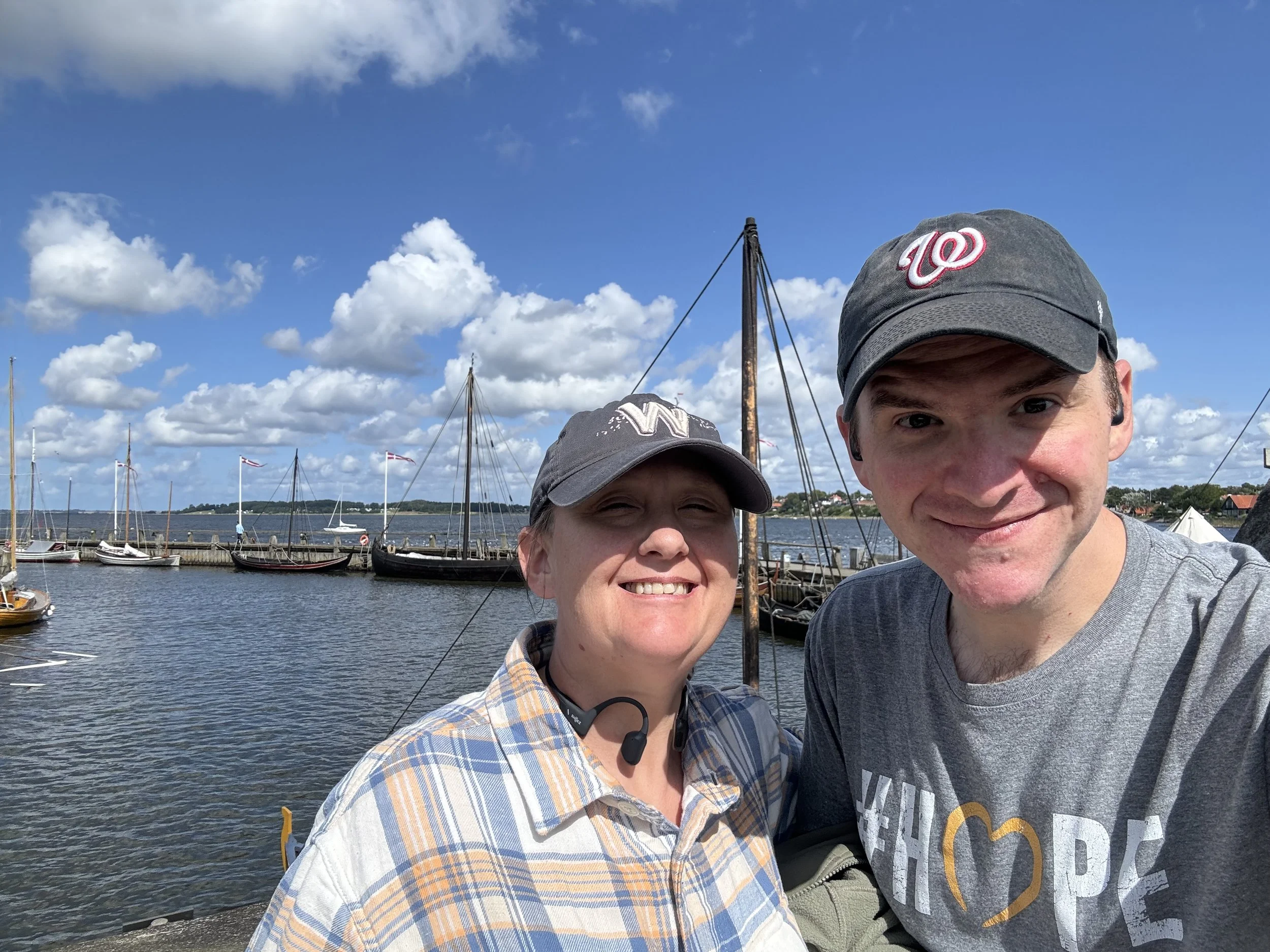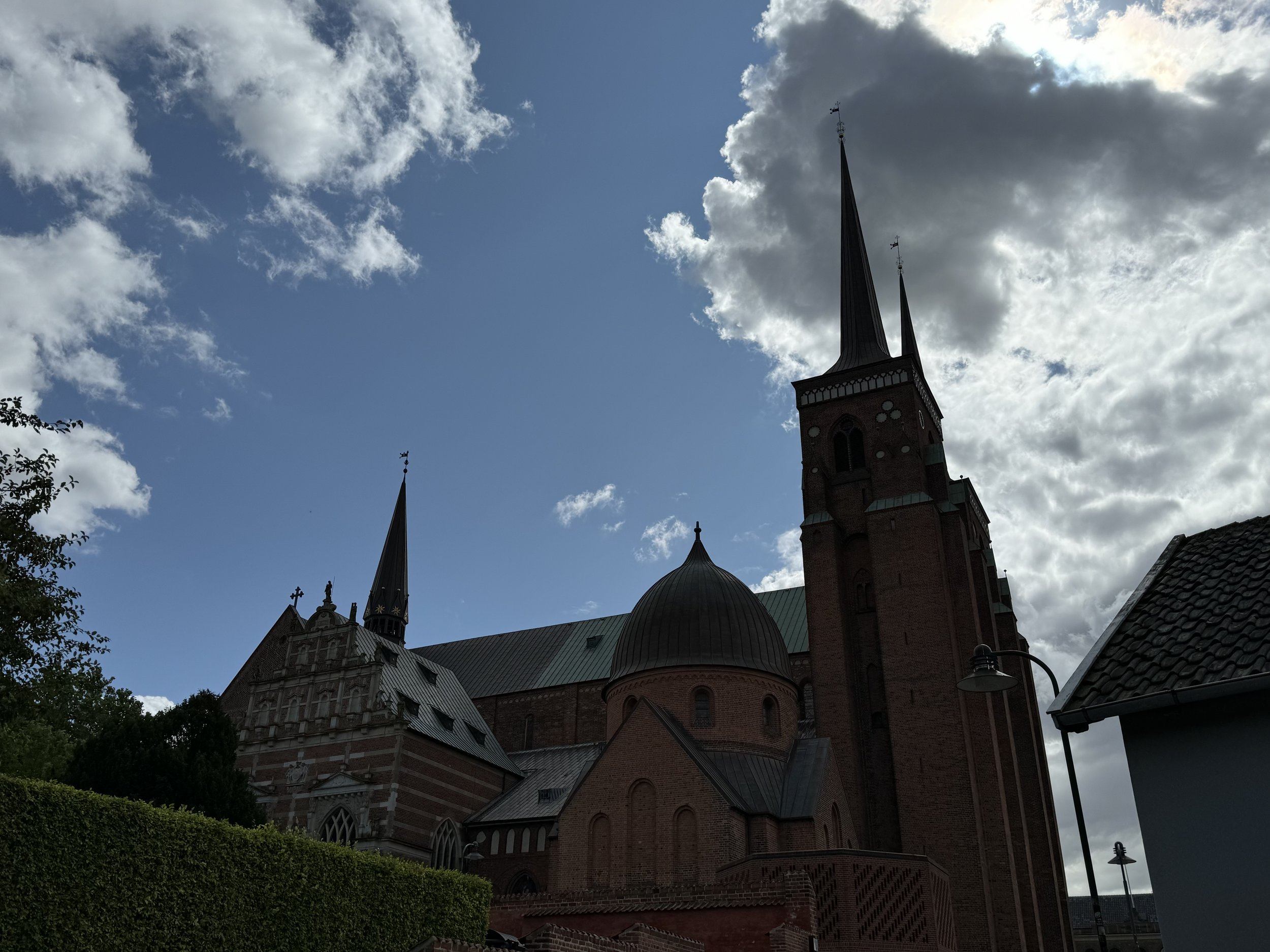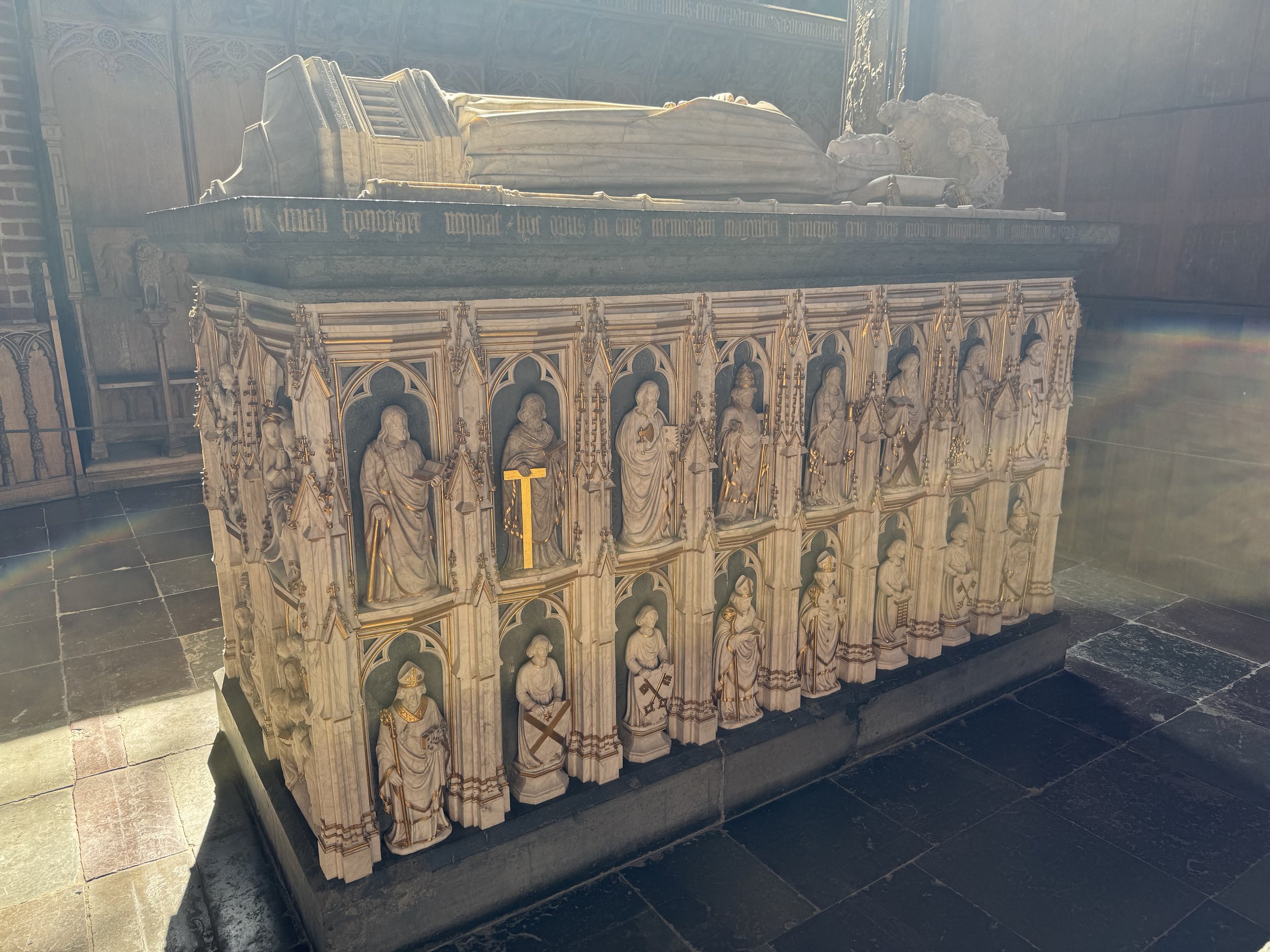Viking Ship Under Construction!
Too bad we’re missing the launch of this ship on Aug 30, 2024! A new Viking Ship from the Faroe Islands.
Today we woke up early, so that we could get on the road to our next destination, Roskilde. Roskilde has a rich history of Viking culture and was actually the capital of Denmark between 1100 CE and 1443 CE. It was supposedly founded with the building of a wooden church by King Harald Bluetooth in 1022. That church was eventually built over with a cathedral, and that cathedral was finally completed in about 1200 CE. No remains of the old wooden church have ever been found, but the city that Harold started flourished and grew. Today it is one of the top 10 Danish cities in population! It is situated at the south side of the Roskilde Fjord, from which Viking ships did much trading and raiding.
“Bluetooth?!” I hear you say, “Isn’t that how I listen to my music wirelessly?” Yes, We all know that the ghostly spirit of Harald Bluetooth is used to connect those headphones to all of your music player devices! Just kidding! BUUUUUUT the connection protocol was definitely named after him, since the Bluetooth standard unites all protocols. Similarly, Harald Bluetooth united the Danish people for the first time. Naming the Bluetooth standard after Harald was a love letter to the Viking culture and history by the man at Intel, who developed the technology. By the way, Bluetooth’s actual nordic rune marking (used to identify him) is used to designate the protocol visually. I guarantee that you’ve seen it before and not known. It’s made up of two runes bound together, H + B:
Two Younger Futhark Runes combined, form Harald Bluetooth’s rune
The Viking Ship Museum
In the 1950s a few divers discovered some wood from a ship in the Roskilde Fjord. They brought it to the Danish government as a possible heritage item from the 1700s and found that the wood dated back to the 1000s! In the coming decades the area around the ships was drained and excavated very carefully to extract the remnants of 5 Viking ships, which were scuttled on top of one another. They found Rocks in the hulls of the ships to weigh them down. How do we know that the Vikings threw rocks into the ships (and that the ships didn’t just decay around the rocks)? They ALSO found boxes of rocks IN the ships. Why? Why were these ships just scuttled in the fjord? Well the fjord is shallow across the narrowest portion, except for a small stretch where it’s deep enough to sail through. Those ships were likely scuttled to plug up that deeper stretch of the fjord and prevent other ships from attacking Roskilde and the other towns/villages around the fjord!
Those scuttled ships were eventually recovered and preserved for all to see. The different ships have different purposes according to their constructions. We took a guided tour of the museum, and I cannot recommend that enough. The guide took us through each type of ship that was recovered and gave us an idea of what they were used for and how they were constructed. There was a longer and thinner war ship, built for speed and agility. There were trading and fishing vessels, built wider for stability. We learned that Viking ships used lapped or overlaid planks. The hulls of the ship are NOT flat. The ships began by constructing the neck/keel/spine of the boat by craftsman who were very well compensated. These craftsmen had to be good at what they did, because the rest of the boat is built around those parts! If you mess up, the ENTIRE boat will be messed up!
Outside the museum is a living history demonstration and Viking ship construction yard! It’s really neat! You can go out on a Viking ship and ride into the fjord, rowing as a team. Currently they are building a ship from the Faroe Islands that will be launched on the day that we are leaving Denmark…BUMMER. We were able to take some cool pictures of the workshop that the ship is being built in. They also use authentic tools, rope, and forged nails to build their ships. You can stand there and watch blacksmiths making parts for the ship, and you can see the ropemaker making rope for the sails and rigging. I was the knot kid in my Boy Scout troop (there’s always one and everyone hates that kid lol), so I tied all the nots on the example board and left them for folks to see how they work. All of them were knots I had learned in Boy Scouts. We grabbed some ice cream to accompany us on our walk up a glorious pathway to the Roskilde Cathedral.
Roskilde Cathedral
The Roskilde Domkirke was originally a catholic church, but was made into a Lutheran church after the Reformation. It was the ONLY cathedral in Denmark until the 20th century! Today the church is the official burial place for all of the Danish regents, and because some of them were also king or queen of Norway (Denmark ruled them for a while), the cathedral has one or two of Norway’s regents as well. There are over 1000 people estimated to be buried in the church, but we don’t know who all of them are. The floor of the church is strewn with the human-sized gravestones and epitaphs of Danish citizens. There are burial vaults for all kinds of people built into the the chancellery from all sides. One such chamber hosts the coffins of the children of the royal family. The kings and queens of Denmark get their own lavish chapels built onto the cathedral with opulent raised caskets. Their tombs are coated with lovely velvet, and the finest wood. They are hewn from the finest stone, and they are gilt in gold, and copper and silver. They are adorned with the symbols of state and with the symbols customary to their times. They seem to be never ending. There are so very many of them, and each of them is a testament to the grandness of the sovereign and the master craftsmen, who made these caskets. In particular the monuments to Christian III and Frederik II were amazing. They sepulchral monuments which stand at least 15 ft high (if not 20). They are essentially copies of each other with some minor differences to detail. Frederik II’s name panel is incomplete because the architect died before the monument was completed. There are 4 men dressed in classical Roman attire standing around the monuments. Each king is depicted as alive on the top of the monument, reading a book and praying. Down below, they lay in repose, dead and gone…well gone as you can be with these gigantic monuments marking where your body lies. They are both entombed underneath the monument as are their wives.
There were some interesting descriptions of some of the kings in the endless rooms of coffins and caskets and tombs. A few of the placards described a king or two as not wanting to be king, and they drove the country near to bankruptcy or were known for throwing lavish parties. Others described unfortunate circumstances such as a king that was schizophrenic, and was constantly bullied. He then died very young. Yet, the great majority of the kings and queens in the cathedral were memorialized, rightly, as heroes of their country, who embodied the values of their people.
After the cathedral, we had a bit of a rest and went out for a sumptuous dinner at a restaurant called Rib house. BUT - in typical Danish fashion, a reservation was required. So, we quickly made a reservation for about 45 minutes later and went for a short walk. On our walk, we found an old cemetery right across from the train station - Gråbrødre Kirkegård (Greyfriars Cemetery). While there, we found the grave of Christoph(er) Ernst Friedrich Weyse, a famous Danish composer who composed a number of songs still in use in Lutheran churches in Denmark today. The tree near his grave has carved musical notes in it! During our short visit to the cemetery, we were treated to a “sun shower” and the most beautiful, vibrant rainbow we’ve ever seen. It was stunning!
Finally, we wandered back to the restaurant where we had rather a good meal, and we’re both exhausted. Tomorrow we make our way to Hillerød by way of…Copenhagen. That’s right., we have to take a train BACK to Copenhagen in order to take another train to Hillerød. That was my mistake when scheduling this trip, I applied United States visual distance standards to the area of Zealand, Denmark. I had thought for sure that the distances between these places justified an overnight stay. Although, while Roskilde might have been easier to accomplish as a day-trip for the logistics, we are both glad that we took the time to overnight here and experience the city a little more than we might have if we rushing to catch a train back to Copenhagen at the end of the day.
We’ll see you all there!
























































